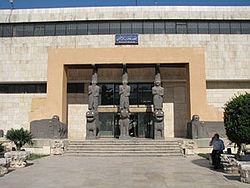- National Museum of Aleppo
-
Coordinates: 36°12′14″N 37°09′02″E / 36.203754°N 37.150607°E
National Museum of Aleppo
Arabic: متحف حلب الوطني
The main entrance, a temple gateway from the Iron Age Neo Hittite settlement of Tell HalafEstablished 1931 Location Baron Street, Aleppo, Syria Type Historical The National Museum of Aleppo (Arabic: متحف حلب الوطني) is the largest museum in the city of Aleppo, founded in 1931. It is located in the heart of the northern city on Baron Street, adjacent to the famous Baron Hotel and near the Bab al-Faraj clock tower. The majority of the museum's exhibitions are devoted to the archaeology of Syria, with most of the finds coming from archaeological sites of the northern part of the country.
Contents
History of the museum
In 1931, under the decision of the Syrian authorities, a small Ottoman palace was designated to become the National Museum in the city of Aleppo. After three decades, the building became too small to host the growing number of exhibited items. Therefore, it was decided in 1966 to demolish the old building and replace it with a larger, more modern structure.
Collections
All historical periods are exhibited in the museum, however the greatest emphasis is put on the Iron Age, while there is a quite big Islamic section. The entrance is a temple gateway with a female sphinx from the Iron Age (9th century BC) Neo-Hittite settlement of Tell Halaf.
Ground floor
The ground floor consists of two main sections: the Section of Prehistoric Culture and the Section of Ancient Syrian Civilizations. The first section is a big hall which contains numerous samples of Stone Age human items and tools found in Aleppo, Ain Dara and Ebla. It also contains the oldest civilized human shelter (8500 BC) brought from Mureybet.
The second section consists of a group of halls, classified geographically according to the Syrian regions and dedicated to the ancient civilizations of Syria. Many Bronze Age objects from Hama and Ugarit are exhibited in these halls, statues and cuneiform scripts from Mari, as well as pieces discovered by Max Mallowan at the site of Tell Brak. Moreover, Iron Age materials and Assyrian style statues from archeological sites of the Al-Jazeera region, and the Euphrates region could be found.[1]
The main halls of this section are:
- The Hall of Al Jazeera Hills.
- The Hall of Mari.
- The Hall of Hama Region.
- The Hall of Ugarit.
- The Hall of Tell Halaf.
- The Hall of Arslan Tash.
- The Hall of Tell Ahmar.
- The Hall of Ancient Statues and Cuneiform Scripts.
- The Hall of Ebla.
Second floor
The upper floor of the museum contains three sections:
- The Section of Classical Remnants: Exhibits several objects of Greek, Hellenistic, Roman and Byzantine periods, such as coins, mosaics glassware and potteries.
- The Section of Arabic-Islamic History: This section contains several Arabic coins, manuscripts, potteries and a Islamic 12th century tomb and a 12th century astrolabe.
- The Section of Modern Art: Dedicated to the modern artists of Aleppo and Syria. It contains a scale model of the old city of Aleppo and a sixth-century fantastic mosaic.
Courtyard
The internal courtyard of the museum is the home of huge basaltic statues of ancient Hittite and Roman mythological characters and a big third-century mosaic figure, while in the front courtyard, monuments of Assyrian, Aramaic, Byzantine and Arabic origins are exhibited[2].
Gallery
-
A historical statue from Mari
See also
References
- ^ "Syria gate: Aleppo Museum". Syriagate.com. http://www.syriagate.com/Syria/about/cities/Aleppo/museum.htm. Retrieved 2009-08-12.
- ^ "Aleppo.us: Aleppo Museum". Aleppo.us. http://www.aleppo.us/news/4.html. Retrieved 2009-08-12.[dead link]
Categories:- Museums in Syria
- Buildings and structures in Aleppo
Wikimedia Foundation. 2010.





